air condition FIAT SCUDO 2010 Owner handbook (in English)
[x] Cancel search | Manufacturer: FIAT, Model Year: 2010, Model line: SCUDO, Model: FIAT SCUDO 2010Pages: 210, PDF Size: 3.32 MB
Page 45 of 210
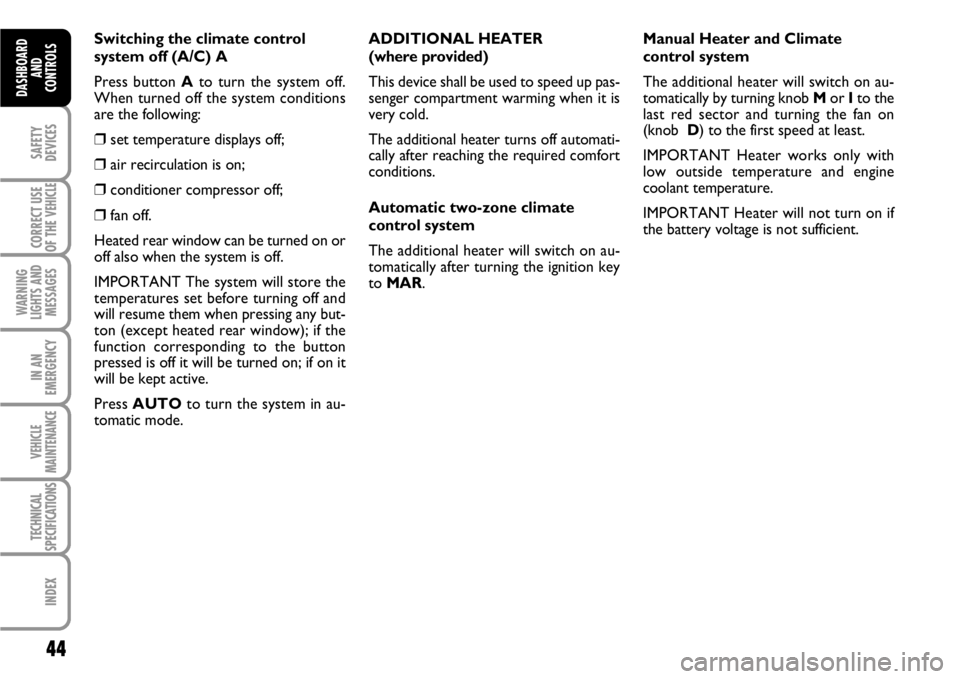
44
SAFETY
DEVICES
CORRECT USE
OF THE
VEHICLE
WARNING
LIGHTS AND
MESSAGES
IN AN
EMERGENCY
VEHICLE
MAINTENANCE
TECHNICAL
SPECIFICATIONS
INDEX
DASHBOARD
AND
CONTROLS
Switching the climate control
system off (A/C) A
Press button Ato turn the system off.
When turned off the system conditions
are the following:
❒set temperature displays off;
❒air recirculation is on;
❒conditioner compressor off;
❒fan off.
Heated rear window can be turned on or
off also when the system is off.
IMPORTANT The system will store the
temperatures set before turning off and
will resume them when pressing any but-
ton (except heated rear window); if the
function corresponding to the button
pressed is off it will be turned on; if on it
will be kept active.
Press AUTOto turn the system in au-
tomatic mode.ADDITIONAL HEATER
(where provided)
This device shall be used to speed up pas-
senger compartment warming when it is
very cold.
The additional heater turns off automati-
cally after reaching the required comfort
conditions.
Automatic two-zone climate
control system
The additional heater will switch on au-
tomatically after turning the ignition key
to MAR.Manual Heater and Climate
control system
The additional heater will switch on au-
tomatically by turning knob M or Ito the
last red sector and turning the fan on
(knob D) to the first speed at least.
IMPORTANT Heater works only with
low outside temperature and engine
coolant temperature.
IMPORTANT Heater will not turn on if
the battery voltage is not sufficient.
Page 47 of 210
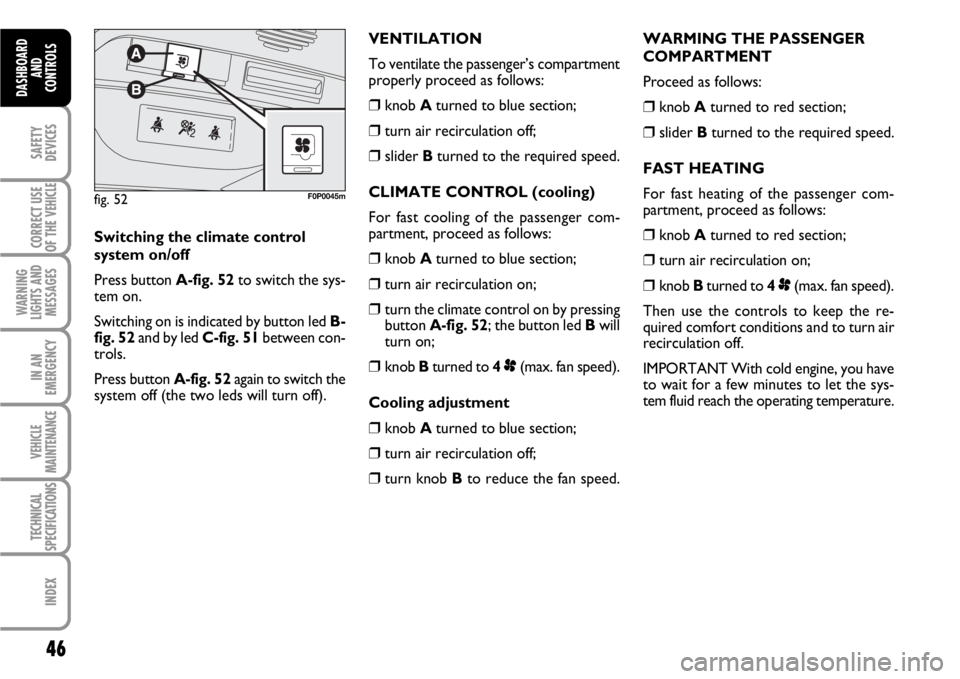
46
SAFETY
DEVICES
CORRECT USE
OF THE
VEHICLE
WARNING
LIGHTS AND
MESSAGES
IN AN
EMERGENCY
VEHICLE
MAINTENANCE
TECHNICAL
SPECIFICATIONS
INDEX
DASHBOARD
AND
CONTROLS
WARMING THE PASSENGER
COMPARTMENT
Proceed as follows:
❒knob Aturned to red section;
❒slider Bturned to the required speed.
FAST HEATING
For fast heating of the passenger com-
partment, proceed as follows:
❒knob Aturned to red section;
❒turn air recirculation on;
❒knob Bturned to 4p(max. fan speed).
Then use the controls to keep the re-
quired comfort conditions and to turn air
recirculation off.
IMPORTANT With cold engine, you have
to wait for a few minutes to let the sys-
tem fluid reach the operating temperature.
fig. 52F0P0045m
Switching the climate control
system on/off
Press button A-fig. 52to switch the sys-
tem on.
Switching on is indicated by button led B-
fig. 52and by led C-fig. 51between con-
trols.
Press button A-fig. 52again to switch the
system off (the two leds will turn off).VENTILATION
To ventilate the passenger’s compartment
properly proceed as follows:
❒knob Aturned to blue section;
❒turn air recirculation off;
❒slider Bturned to the required speed.
CLIMATE CONTROL (cooling)
For fast cooling of the passenger com-
partment, proceed as follows:
❒knob Aturned to blue section;
❒turn air recirculation on;
❒turn the climate control on by pressing
button A-fig. 52; the button led Bwill
turn on;
❒knob Bturned to 4p(max. fan speed).
Cooling adjustment
❒knob Aturned to blue section;
❒turn air recirculation off;
❒turn knob Bto reduce the fan speed.
Page 119 of 210
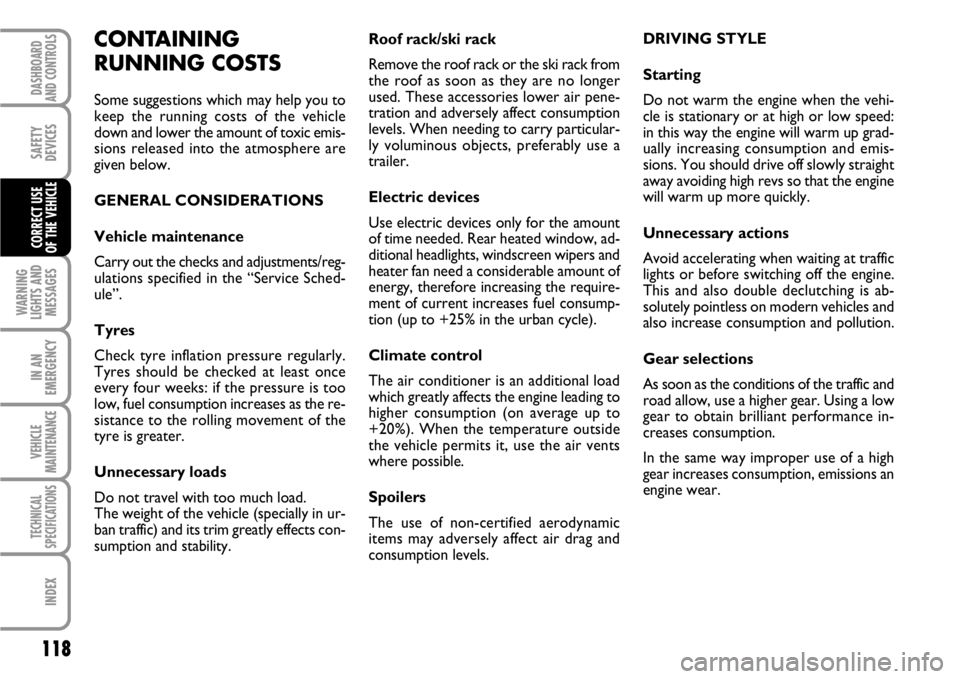
118
WARNING
LIGHTS AND
MESSAGES
IN AN
EMERGENCY
VEHICLE
MAINTENANCE
TECHNICAL
SPECIFICATIONS
INDEX
DASHBOARD
AND CONTROLS
SAFETY
DEVICES
CORRECT USE
OF THE VEHICLE
Roof rack/ski rack
Remove the roof rack or the ski rack from
the roof as soon as they are no longer
used. These accessories lower air pene-
tration and adversely affect consumption
levels. When needing to carry particular-
ly voluminous objects, preferably use a
trailer.
Electric devices
Use electric devices only for the amount
of time needed. Rear heated window, ad-
ditional headlights, windscreen wipers and
heater fan need a considerable amount of
energy, therefore increasing the require-
ment of current increases fuel consump-
tion (up to +25% in the urban cycle).
Climate control
The air conditioner is an additional load
which greatly affects the engine leading to
higher consumption (on average up to
+20%). When the temperature outside
the vehicle permits it, use the air vents
where possible.
Spoilers
The use of non-certified aerodynamic
items may adversely affect air drag and
consumption levels.DRIVING STYLE
Starting
Do not warm the engine when the vehi-
cle is stationary or at high or low speed:
in this way the engine will warm up grad-
ually increasing consumption and emis-
sions. You should drive off slowly straight
away avoiding high revs so that the engine
will warm up more quickly.
Unnecessary actions
Avoid accelerating when waiting at traffic
lights or before switching off the engine.
This and also double declutching is ab-
solutely pointless on modern vehicles and
also increase consumption and pollution.
Gear selections
As soon as the conditions of the traffic and
road allow, use a higher gear. Using a low
gear to obtain brilliant performance in-
creases consumption.
In the same way improper use of a high
gear increases consumption, emissions an
engine wear.CONTAINING
RUNNING COSTS
Some suggestions which may help you to
keep the running costs of the vehicle
down and lower the amount of toxic emis-
sions released into the atmosphere are
given below.
GENERAL CONSIDERATIONS
Vehicle maintenance
Carry out the checks and adjustments/reg-
ulations specified in the “Service Sched-
ule”.
Tyres
Check tyre inflation pressure regularly.
Tyres should be checked at least once
every four weeks: if the pressure is too
low, fuel consumption increases as the re-
sistance to the rolling movement of the
tyre is greater.
Unnecessary loads
Do not travel with too much load.
The weight of the vehicle (specially in ur-
ban traffic) and its trim greatly effects con-
sumption and stability.
Page 126 of 210
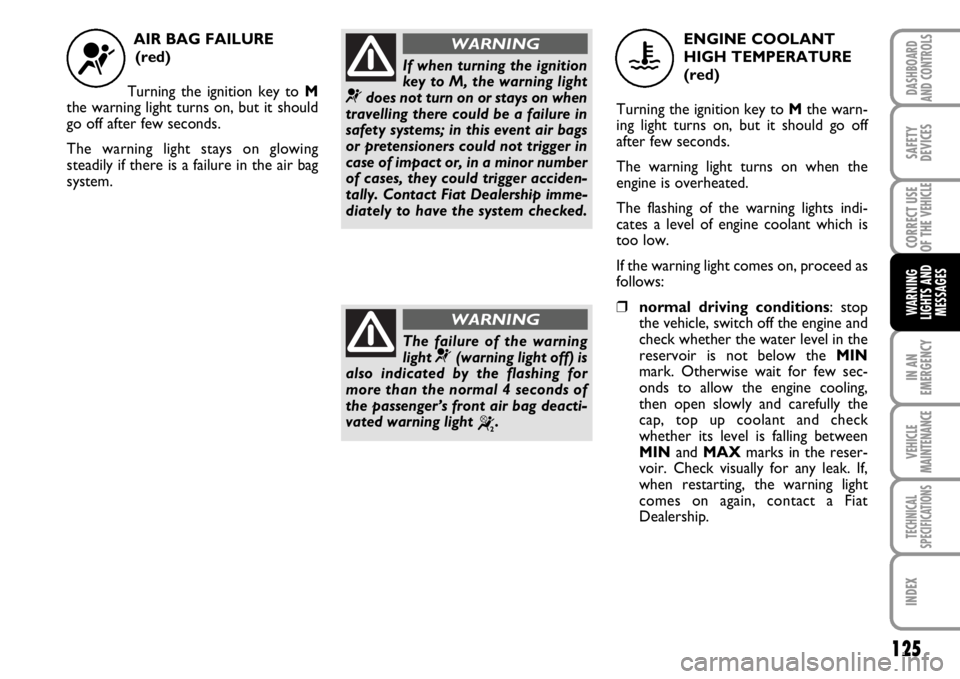
125
IN AN
EMERGENCY
VEHICLE
MAINTENANCE
TECHNICAL
SPECIFICATIONS
INDEX
DASHBOARD
AND CONTROLS
SAFETY
DEVICES
CORRECT USE
OF THE
VEHICLE
WARNING
LIGHTS AND
MESSAGES
AIR BAG FAILURE
(red)
Turning the ignition key to M
the warning light turns on, but it should
go off after few seconds.
The warning light stays on glowing
steadily if there is a failure in the air bag
system.
¬If when turning the ignition
key to M, the warning light
¬does not turn on or stays on when
travelling there could be a failure in
safety systems; in this event air bags
or pretensioners could not trigger in
case of impact or, in a minor number
of cases, they could trigger acciden-
tally. Contact Fiat Dealership imme-
diately to have the system checked.
WARNING
The failure of the warning
light ¬(warning light off) is
also indicated by the flashing for
more than the normal 4 seconds of
the passenger’s front air bag deacti-
vated warning light
“.
WARNING
ENGINE COOLANT
HIGH TEMPERATURE
(red)
Turning the ignition key to Mthe warn-
ing light turns on, but it should go off
after few seconds.
The warning light turns on when the
engine is overheated.
The flashing of the warning lights indi-
cates a level of engine coolant which is
too low.
If the warning light comes on, proceed as
follows:
❒normal driving conditions: stop
the vehicle, switch off the engine and
check whether the water level in the
reservoir is not below the MIN
mark. Otherwise wait for few sec-
onds to allow the engine cooling,
then open slowly and carefully the
cap, top up coolant and check
whether its level is falling between
MINand MAXmarks in the reser-
voir. Check visually for any leak. If,
when restarting, the warning light
comes on again, contact a Fiat
Dealership.
u
Page 157 of 210
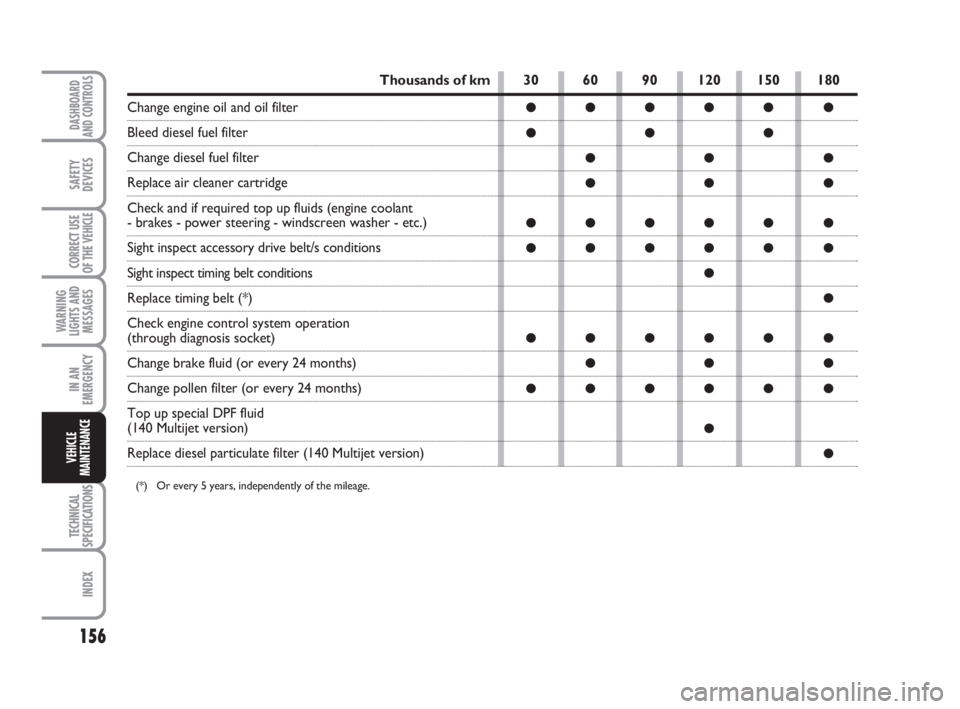
156
WARNING
LIGHTS AND
MESSAGES
TECHNICAL
SPECIFICATIONS
INDEX
DASHBOARD
AND CONTROLS
SAFETY
DEVICES
CORRECT USE
OF THE
VEHICLE
IN AN
EMERGENCY
VEHICLE
MAINTENANCE
30 60 90 120 150 180
●●●●● ●
●●●
●● ●
●● ●
●●●●● ●
●●●●● ●
●
●
●●●●● ●
●● ●
●●●●● ●
●
●
Thousands of km
Change engine oil and oil filter
Bleed diesel fuel filter
Change diesel fuel filter
Replace air cleaner cartridge
Check and if required top up fluids (engine coolant
- brakes - power steering - windscreen washer - etc.)
Sight inspect accessory drive belt/s conditions
Sight inspect timing belt conditions
Replace timing belt (*)
Check engine control system operation
(through diagnosis socket)
Change brake fluid (or every 24 months)
Change pollen filter (or every 24 months)
Top up special DPF fluid
(140 Multijet version)
Replace diesel particulate filter (140 Multijet version)
(*) Or every 5 years, independently of the mileage.
153-172 Nuovo ScudoG9 GB:153-172 Nuovo ScudoG9 GB 16-11-2009 12:04 Pagina 156
Page 158 of 210
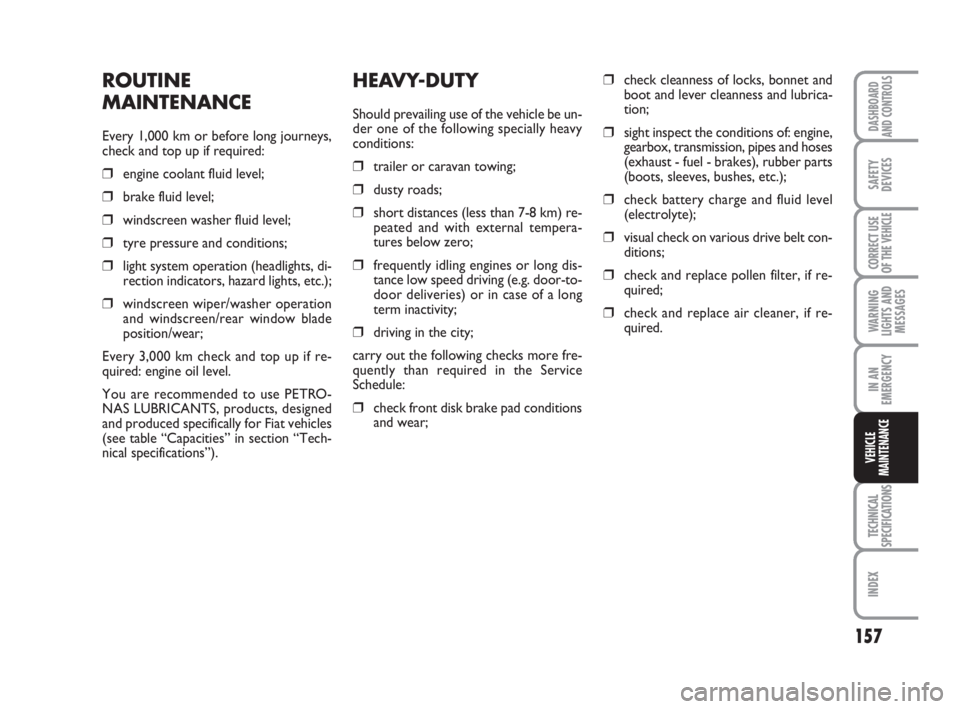
157
WARNING
LIGHTS AND
MESSAGES
TECHNICAL
SPECIFICATIONS
INDEX
DASHBOARD
AND CONTROLS
SAFETY
DEVICES
CORRECT USE
OF THE
VEHICLE
IN AN
EMERGENCY
VEHICLE
MAINTENANCE
HEAVY-DUTY
Should prevailing use of the vehicle be un-
der one of the following specially heavy
conditions:
❒trailer or caravan towing;
❒dusty roads;
❒short distances (less than 7-8 km) re-
peated and with external tempera-
tures below zero;
❒frequently idling engines or long dis-
tance low speed driving (e.g. door-to-
door deliveries) or in case of a long
term inactivity;
❒driving in the city;
carry out the following checks more fre-
quently than required in the Service
Schedule:
❒check front disk brake pad conditions
and wear;
❒check cleanness of locks, bonnet and
boot and lever cleanness and lubrica-
tion;
❒sight inspect the conditions of: engine,
gearbox, transmission, pipes and hoses
(exhaust - fuel - brakes), rubber parts
(boots, sleeves, bushes, etc.);
❒check battery charge and fluid level
(electrolyte);
❒visual check on various drive belt con-
ditions;
❒check and replace pollen filter, if re-
quired;
❒check and replace air cleaner, if re-
quired.
ROUTINE
MAINTENANCE
Every 1,000 km or before long journeys,
check and top up if required:
❒engine coolant fluid level;
❒brake fluid level;
❒windscreen washer fluid level;
❒tyre pressure and conditions;
❒light system operation (headlights, di-
rection indicators, hazard lights, etc.);
❒windscreen wiper/washer operation
and windscreen/rear window blade
position/wear;
Every 3,000 km check and top up if re-
quired: engine oil level.
You are recommended to use PETRO-
NAS LUBRICANTS, products, designed
and produced specifically for Fiat vehicles
(see table “Capacities” in section “Tech-
nical specifications”).
153-172 Nuovo ScudoG9 GB:153-172 Nuovo ScudoG9 GB 16-11-2009 12:04 Pagina 157
Page 165 of 210
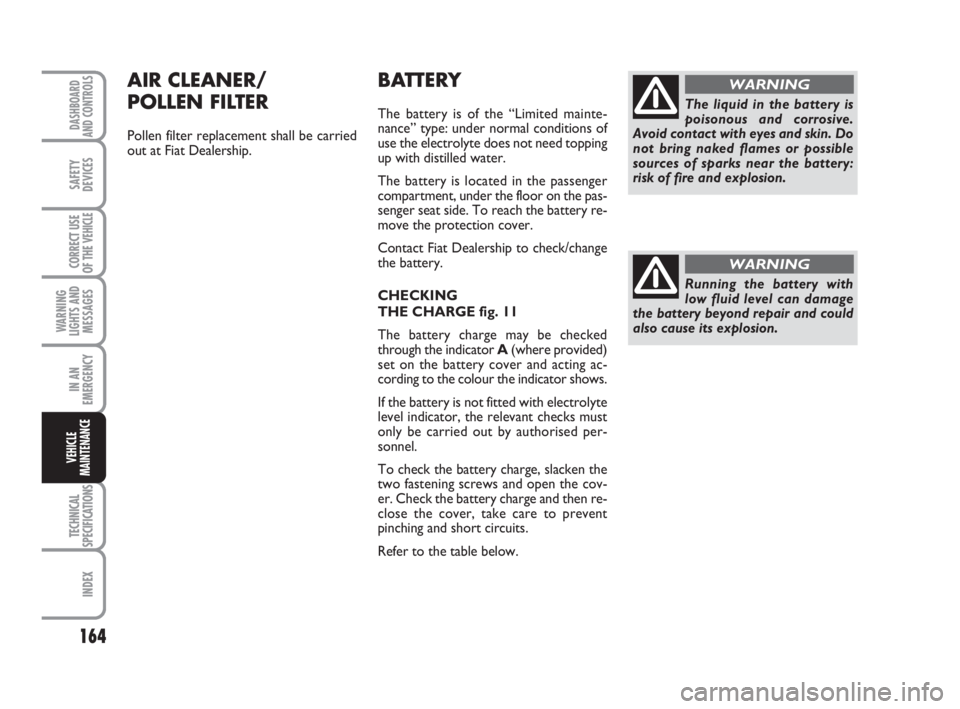
164
WARNING
LIGHTS AND
MESSAGES
TECHNICAL
SPECIFICATIONS
INDEX
DASHBOARD
AND CONTROLS
SAFETY
DEVICES
CORRECT USE
OF THE
VEHICLE
IN AN
EMERGENCY
VEHICLE
MAINTENANCE
BATTERY
The battery is of the “Limited mainte-
nance” type: under normal conditions of
use the electrolyte does not need topping
up with distilled water.
The battery is located in the passenger
compartment, under the floor on the pas-
senger seat side. To reach the battery re-
move the protection cover.
Contact Fiat Dealership to check/change
the battery.
CHECKING
THE CHARGE fig. 11
The battery charge may be checked
through the indicator A(where provided)
set on the battery cover and acting ac-
cording to the colour the indicator shows.
If the battery is not fitted with electrolyte
level indicator, the relevant checks must
only be carried out by authorised per-
sonnel.
To check the battery charge, slacken the
two fastening screws and open the cov-
er. Check the battery charge and then re-
close the cover, take care to prevent
pinching and short circuits.
Refer to the table below.The liquid in the battery is
poisonous and corrosive.
Avoid contact with eyes and skin. Do
not bring naked flames or possible
sources of sparks near the battery:
risk of fire and explosion.
WARNING
Running the battery with
low fluid level can damage
the battery beyond repair and could
also cause its explosion.
WARNING
AIR CLEANER/
POLLEN FILTER
Pollen filter replacement shall be carried
out at Fiat Dealership.
153-172 Nuovo ScudoG9 GB:153-172 Nuovo ScudoG9 GB 16-11-2009 12:05 Pagina 164
Page 171 of 210
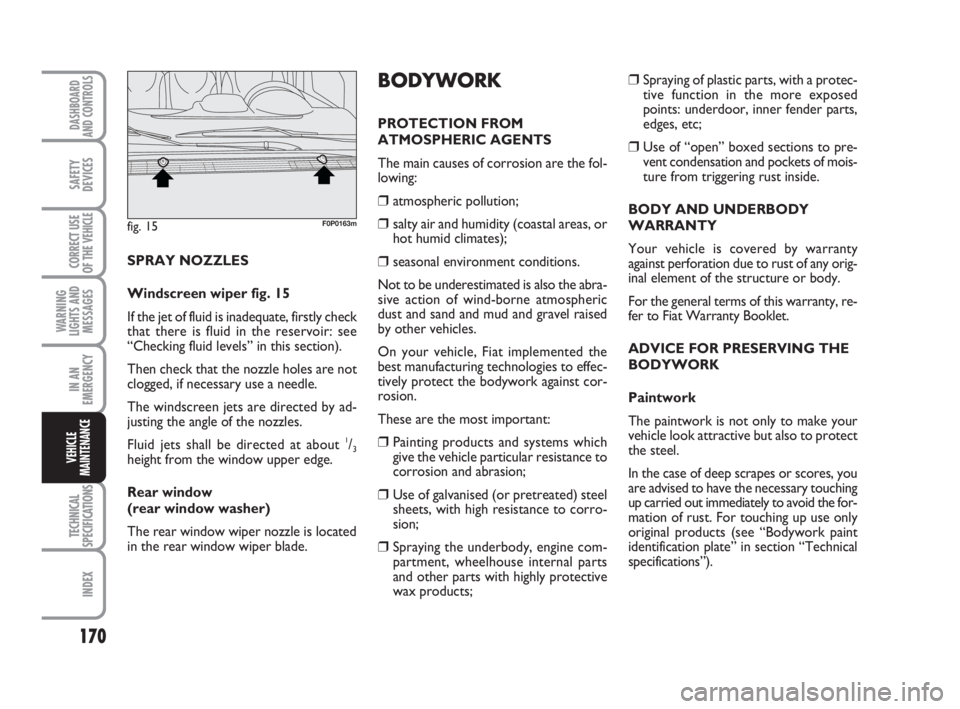
170
WARNING
LIGHTS AND
MESSAGES
TECHNICAL
SPECIFICATIONS
INDEX
DASHBOARD
AND CONTROLS
SAFETY
DEVICES
CORRECT USE
OF THE
VEHICLE
IN AN
EMERGENCY
VEHICLE
MAINTENANCE
❒Spraying of plastic parts, with a protec-
tive function in the more exposed
points: underdoor, inner fender parts,
edges, etc;
❒ Use of “open” boxed sections to pre-
vent condensation and pockets of mois-
ture from triggering rust inside.
BODY AND UNDERBODY
WARRANTY
Your vehicle is covered by warranty
against perforation due to rust of any orig-
inal element of the structure or body.
For the general terms of this warranty, re-
fer to Fiat Warranty Booklet.
ADVICE FOR PRESERVING THE
BODYWORK
Paintwork
The paintwork is not only to make your
vehicle look attractive but also to protect
the steel.
In the case of deep scrapes or scores, you
are advised to have the necessary touching
up carried out immediately to avoid the for-
mation of rust. For touching up use only
original products (see “Bodywork paint
identification plate” in section “Technical
specifications”).
BODYWORK
PROTECTION FROM
ATMOSPHERIC AGENTS
The main causes of corrosion are the fol-
lowing:
❒ atmospheric pollution;
❒ salty air and humidity (coastal areas, or
hot humid climates);
❒ seasonal environment conditions.
Not to be underestimated is also the abra-
sive action of wind-borne atmospheric
dust and sand and mud and gravel raised
by other vehicles.
On your vehicle, Fiat implemented the
best manufacturing technologies to effec-
tively protect the bodywork against cor-
rosion.
These are the most important:
❒ Painting products and systems which
give the vehicle particular resistance to
corrosion and abrasion;
❒ Use of galvanised (or pretreated) steel
sheets, with high resistance to corro-
sion;
❒ Spraying the underbody, engine com-
partment, wheelhouse internal parts
and other parts with highly protective
wax products; SPRAY NOZZLES
Windscreen wiper fig. 15
If the jet of fluid is inadequate, firstly check
that there is fluid in the reservoir: see
“Checking fluid levels” in this section).
Then check that the nozzle holes are not
clogged, if necessary use a needle.
The windscreen jets are directed by ad-
justing the angle of the nozzles.
Fluid jets shall be directed at about
1/3height from the window upper edge.
Rear window
(rear window washer)
The rear window wiper nozzle is located
in the rear window wiper blade.
fig. 15F0P0163m
153-172 Nuovo ScudoG9 GB:153-172 Nuovo ScudoG9 GB 16-11-2009 12:05 Pagina 170
Page 198 of 210
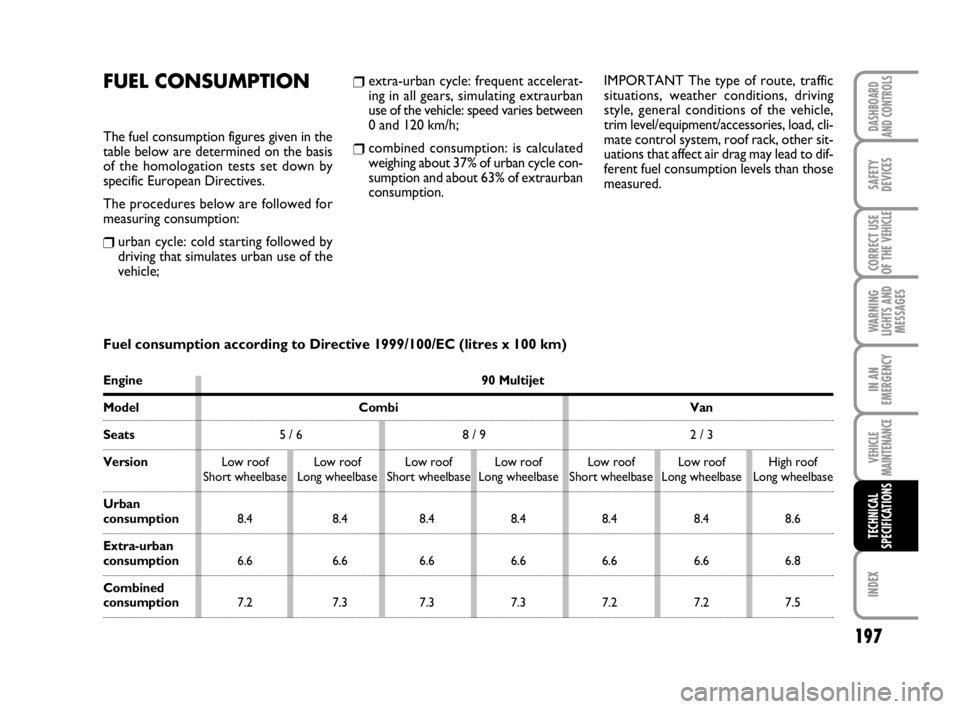
197
WARNING
LIGHTS AND
MESSAGES
INDEX
DASHBOARD
AND CONTROLS
SAFETY
DEVICES
CORRECT USE
OF THE
VEHICLE
IN AN
EMERGENCY
VEHICLE
MAINTENANCE
TECHNICAL
SPECIFICATIONS
❒extra-urban cycle: frequent accelerat-
ing in all gears, simulating extraurban
use of the vehicle: speed varies between
0 and 120 km/h;
❒combined consumption: is calculated
weighing about 37% of urban cycle con-
sumption and about 63% of extraurban
consumption.
FUEL CONSUMPTION
The fuel consumption figures given in the
table below are determined on the basis
of the homologation tests set down by
specific European Directives.
The procedures below are followed for
measuring consumption:
❒urban cycle: cold starting followed by
driving that simulates urban use of the
vehicle;IMPORTANT The type of route, traffic
situations, weather conditions, driving
style, general conditions of the vehicle,
trim level/equipment/accessories, load, cli-
mate control system, roof rack, other sit-
uations that affect air drag may lead to dif-
ferent fuel consumption levels than those
measured.
Fuel consumption according to Directive 1999/100/EC (litres x 100 km)
Engine 90 Multijet
Model Combi Van
Seats5 / 6 8 / 9 2 / 3
VersionLow roof Low roof Low roof Low roof Low roof Low roof High roof
Short wheelbase Long wheelbase Short wheelbase Long wheelbase Short wheelbase Long wheelbase Long wheelbase
Urban
consumption8.4 8.4 8.4 8.4 8.4 8.4 8.6
Extra-urban
consumption6.6 6.6 6.6 6.6 6.6 6.6 6.8
Combined
consumption7.2 7.3 7.3 7.3 7.2 7.2 7.5
173-199 Nuovo ScudoG9 GB.qxd:173-199 Nuovo ScudoG9 GB 10-12-09 16:17 Page 197